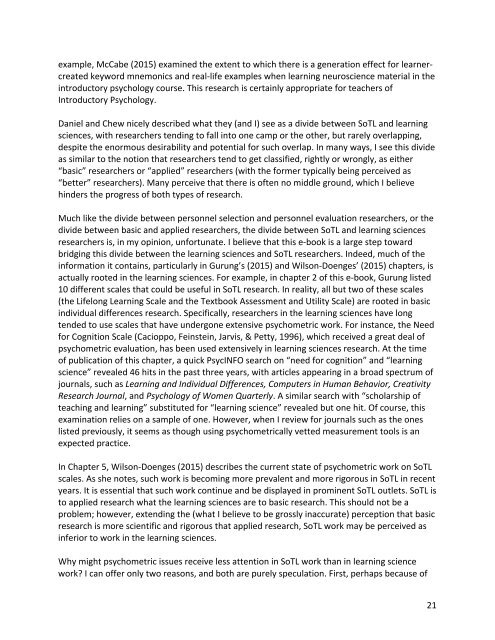A COMPENDIUM OF SCALES for use in the SCHOLARSHIP OF TEACHING AND LEARNING
compscalesstl
compscalesstl
You also want an ePaper? Increase the reach of your titles
YUMPU automatically turns print PDFs into web optimized ePapers that Google loves.
example, McCabe (2015) exam<strong>in</strong>ed <strong>the</strong> extent to which <strong>the</strong>re is a generation effect <strong>for</strong> learnercreated<br />
keyword mnemonics and real-life examples when learn<strong>in</strong>g neuroscience material <strong>in</strong> <strong>the</strong><br />
<strong>in</strong>troductory psychology course. This research is certa<strong>in</strong>ly appropriate <strong>for</strong> teachers of<br />
Introductory Psychology.<br />
Daniel and Chew nicely described what <strong>the</strong>y (and I) see as a divide between SoTL and learn<strong>in</strong>g<br />
sciences, with researchers tend<strong>in</strong>g to fall <strong>in</strong>to one camp or <strong>the</strong> o<strong>the</strong>r, but rarely overlapp<strong>in</strong>g,<br />
despite <strong>the</strong> enormous desirability and potential <strong>for</strong> such overlap. In many ways, I see this divide<br />
as similar to <strong>the</strong> notion that researchers tend to get classified, rightly or wrongly, as ei<strong>the</strong>r<br />
“basic” researchers or “applied” researchers (with <strong>the</strong> <strong>for</strong>mer typically be<strong>in</strong>g perceived as<br />
“better” researchers). Many perceive that <strong>the</strong>re is often no middle ground, which I believe<br />
h<strong>in</strong>ders <strong>the</strong> progress of both types of research.<br />
Much like <strong>the</strong> divide between personnel selection and personnel evaluation researchers, or <strong>the</strong><br />
divide between basic and applied researchers, <strong>the</strong> divide between SoTL and learn<strong>in</strong>g sciences<br />
researchers is, <strong>in</strong> my op<strong>in</strong>ion, un<strong>for</strong>tunate. I believe that this e-book is a large step toward<br />
bridg<strong>in</strong>g this divide between <strong>the</strong> learn<strong>in</strong>g sciences and SoTL researchers. Indeed, much of <strong>the</strong><br />
<strong>in</strong><strong>for</strong>mation it conta<strong>in</strong>s, particularly <strong>in</strong> Gurung’s (2015) and Wilson-Doenges’ (2015) chapters, is<br />
actually rooted <strong>in</strong> <strong>the</strong> learn<strong>in</strong>g sciences. For example, <strong>in</strong> chapter 2 of this e-book, Gurung listed<br />
10 different scales that could be <strong>use</strong>ful <strong>in</strong> SoTL research. In reality, all but two of <strong>the</strong>se scales<br />
(<strong>the</strong> Lifelong Learn<strong>in</strong>g Scale and <strong>the</strong> Textbook Assessment and Utility Scale) are rooted <strong>in</strong> basic<br />
<strong>in</strong>dividual differences research. Specifically, researchers <strong>in</strong> <strong>the</strong> learn<strong>in</strong>g sciences have long<br />
tended to <strong>use</strong> scales that have undergone extensive psychometric work. For <strong>in</strong>stance, <strong>the</strong> Need<br />
<strong>for</strong> Cognition Scale (Cacioppo, Fe<strong>in</strong>ste<strong>in</strong>, Jarvis, & Petty, 1996), which received a great deal of<br />
psychometric evaluation, has been <strong>use</strong>d extensively <strong>in</strong> learn<strong>in</strong>g sciences research. At <strong>the</strong> time<br />
of publication of this chapter, a quick PsycINFO search on “need <strong>for</strong> cognition” and “learn<strong>in</strong>g<br />
science” revealed 46 hits <strong>in</strong> <strong>the</strong> past three years, with articles appear<strong>in</strong>g <strong>in</strong> a broad spectrum of<br />
journals, such as Learn<strong>in</strong>g and Individual Differences, Computers <strong>in</strong> Human Behavior, Creativity<br />
Research Journal, and Psychology of Women Quarterly. A similar search with “scholarship of<br />
teach<strong>in</strong>g and learn<strong>in</strong>g” substituted <strong>for</strong> “learn<strong>in</strong>g science” revealed but one hit. Of course, this<br />
exam<strong>in</strong>ation relies on a sample of one. However, when I review <strong>for</strong> journals such as <strong>the</strong> ones<br />
listed previously, it seems as though us<strong>in</strong>g psychometrically vetted measurement tools is an<br />
expected practice.<br />
In Chapter 5, Wilson-Doenges (2015) describes <strong>the</strong> current state of psychometric work on SoTL<br />
scales. As she notes, such work is becom<strong>in</strong>g more prevalent and more rigorous <strong>in</strong> SoTL <strong>in</strong> recent<br />
years. It is essential that such work cont<strong>in</strong>ue and be displayed <strong>in</strong> prom<strong>in</strong>ent SoTL outlets. SoTL is<br />
to applied research what <strong>the</strong> learn<strong>in</strong>g sciences are to basic research. This should not be a<br />
problem; however, extend<strong>in</strong>g <strong>the</strong> (what I believe to be grossly <strong>in</strong>accurate) perception that basic<br />
research is more scientific and rigorous that applied research, SoTL work may be perceived as<br />
<strong>in</strong>ferior to work <strong>in</strong> <strong>the</strong> learn<strong>in</strong>g sciences.<br />
Why might psychometric issues receive less attention <strong>in</strong> SoTL work than <strong>in</strong> learn<strong>in</strong>g science<br />
work? I can offer only two reasons, and both are purely speculation. First, perhaps beca<strong>use</strong> of<br />
21


